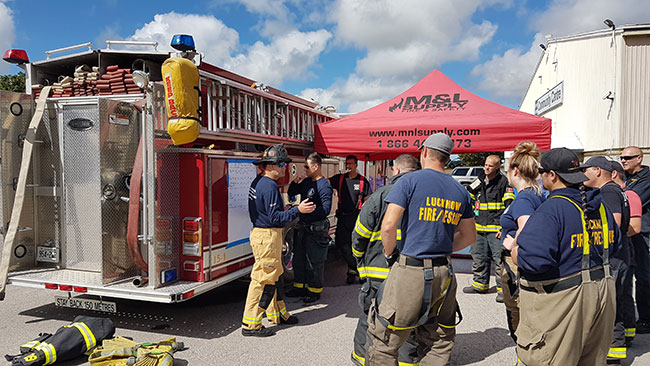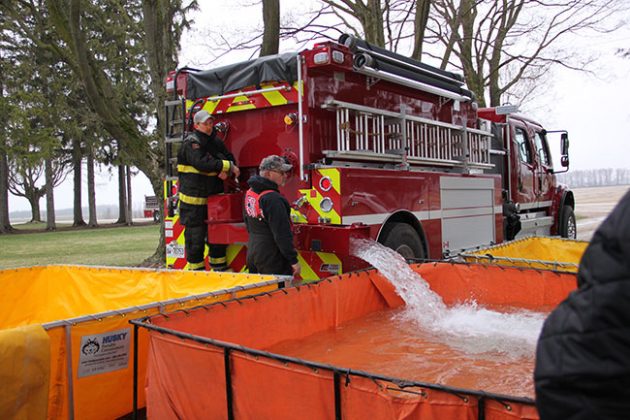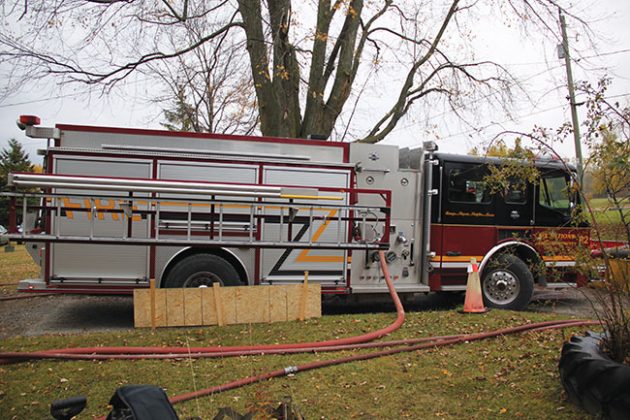
Features
Structural
Training
Back to Basics: Ladder Dating: The weight and feel
August 31, 2020
By Mark van der Feyst
 Photo 1: Ladder mounted on the side above shoulder height. Photos by Mark van der Feyst
Photo 1: Ladder mounted on the side above shoulder height. Photos by Mark van der Feyst
One of the common complaints about ground ladders is the weight of them: “they are too heavy!” This viewpoint has been—and will be—conveyed by many firefighters when asked to grab a ground ladder and they haven’t handled one in a while.
We are continuing with our study on the topic of ladder dating (we need to get to know our ladders just like dating) with a detailed look at the weight and feel of a ground ladder. The ground ladder is an especially useful but underused tool on the fire ground. One reason it is often underused is due to the weight of it.
Now we must address the obvious issue that relates to the weight of a ground ladder: the person themselves. A ground ladder is not a light object, but it is not so heavy that a firefighter cannot easily carry and operate it. Operating a ground ladder does require muscular strength and will require a firefighter to participate in some type of physical fitness routine to build up or maintain that strength. Relying upon an aerial ladder device to always provide ladder support for a structure fire is not always possible or even the best tool to use. The best approach is to use the hydraulic (muscular) support of physical human arms to lift the ladder and place it in position. Firefighters need to work out and this is one of the reasons why.
Besides needing to lift the ladder into position, a firefighter needs to be able to lift/remove/slide the ground ladder from off the fire truck and onto their shoulders. This will involve some physical strength but also some height. Depending upon the location of the ladder bed on the truck, it can be located high, it can be located on a hydraulic arm that will lower down, it may be located at shoulder height, etc. In photos one, two and three, you will see some examples of different ladder locations on various fire trucks. Some have hydraulic lowering arms, and some do not.
Wherever it is located, you need to know where it is on the fire truck. If it’s too high, you should determine ahead of time how you will be able to grab that ground ladder with the height of your body. This is a part of pre-planning—your station, trucks, abilities, limitations—ahead of time before the order comes across to, “ladder that window”.
The one muscle that needs to be exercised with respect to ground ladders, or anything on the fire ground, for that matter, is the memory. We derive the term ‘muscle memory’ from the constant exercising of the muscles, body and mind in a consistent pattern or method that becomes ingrained into the fabric of our being. Muscle memory is where a person does something like tying their shoe on a repetitive basis, the same way, all the time; when they do this, they are able to complete that action without having to really think about it so when they must perform this action (like tying their shoes), they aren’t surprised.
With respect to the weight and feel of a ground ladder, this holds especially true. The body tends to forget things very quickly when it is not exercised on a regular, consistent basis. A firefighter that trains with the 24’ ground ladder for about 30 minutes in the month of April, then never touches it again until November, will have a surprise when they go to remove it, lift or carry it, the ladder will seem too heavy to them.
There are a couple of ladder manufacturers that produce ground ladders for the fire service and most departments will buy their ground ladders from one of these manufactures, unless they are made inhouse like in San Francisco out of wood. Seeing as these ground ladders are mass produced and in service everywhere, a firefighter can train on their ground ladder and then go to the neighboring department and use theirs and still feel confident to do so relying upon their muscle memory.
The aluminum ground ladder with a solid beam construction is going to be the lightest in comparison to a truss beam constructed ladder. Here are some weight differentials based upon the two types based upon one manufacture.
Truss Constructed Style
- 14’ roof ladder – 50 lbs
- 16’ roof ladder – 56 lbs
- 2 section 24’ ladder – 110 lbs
- 2 section 28’ ladder – 118 lbs
- 2 section 35’ ladder – 141 lbs
Solid Beam Style
- 14’ roof ladder – 42 lbs
- 16’ roof ladder – 48 lbs
- 2 section 24’ ladder – 75 lbs
- 2 section 28’ ladder – 114 lbs
- 2 section 35’ ladder – 139 lbs
As you can see from the weights listed above, one firefighter can easily handle a 24’ ground ladder all by themselves—it is not that heavy compared to the truss block construction ladder; many firefighters can handle a 2 section 28’ ground ladder as well.
So, why am I speaking about only one firefighter as opposed to two firefighters? We need to consider manpower limitations and the constant need to have certain skills completed by just one firefighter. There is not always going to be the availability of two sets of hands to operate a ground ladder and if there is, perhaps the tactic of having both firefighters carry a ground each will increase the effectiveness and efficiency of that team by being able to ladder two windows at the same time.
Certainly, if the only ground ladder available is a 35’ or a three-section ladder, it will require at least two firefighters to carry it and operate it, but the majority of ladder work can be accomplished with the use of a 24’ ladder or a 28’ ladder with just one firefighter.
The weight and feel of a ground ladder can be ingrained into the firefighter’s being so whenever they grab that ladder, it will not be a surprise to them as to how much it weighs or how it feels when trying to raise it into position. This will only come with repetitive practice.
Mark van der Feyst has been in the fire service since 1999 and is currently a full-time firefighter with the WFD. He is an international instructor teaching in Canada, the United States, FDIC and India. He is a local level suppression instructor for the Pennsylvania State Fire Academy and the lead Author of Pennwell’s Residential Fire Rescue book. He can be contacted at Mark@FireStarTraining.com.
Print this page
Advertisement
- Embracing technology
- Port Stanley receives $3.7 million from Federal government for new energy-efficient fire station

